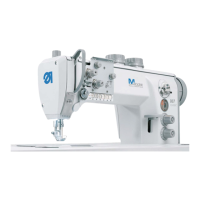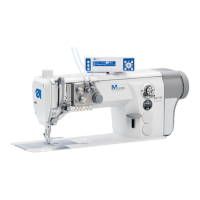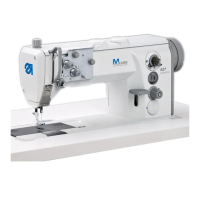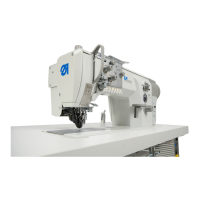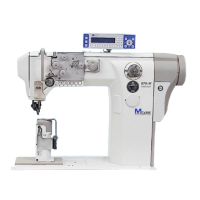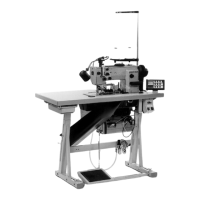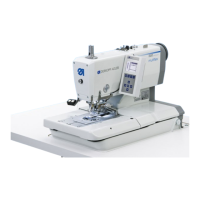
Do you have a question about the DURKOPP ADLER 869-M Premium and is the answer not in the manual?
| Type | Industrial Sewing Machine |
|---|---|
| Stitch Type | Lockstitch |
| Max Stitch Length | 12 mm |
| Weight | Approx. 45 kg |
| Sewing System | Single needle |
| Power Requirements | 230 V, 50/60 Hz |
| Foot Lift | 20 mm |
| Applications | upholstery |
Outlines essential rules for safe operation, maintenance, and personnel requirements.
Explains the meaning of signal words (DANGER, WARNING, CAUTION) and hazard symbols.
Step-by-step guide to enter and use the machine's service routine for adjustments.
Steps to set the stitch regulator gear to zero, ensuring no play and parallel plates.
Procedure to set the eccentric for forward and backward stitches to ensure equal length.
Ensures the needle pierces the center of the feed dog's needle hole at stitch length zero.
Aligns the feed dog's elliptical movement, stroke height, and stroke movement.
Steps to align the needle bar linkage sideways for accurate needle piercing in the needle hole.
Ensures correct needle bar linkage alignment in the sewing direction for proper piercing.
Adjusts the distance between the hook tip and needle groove to a maximum of 0.1 mm.
Ensures the loop stroke is precisely 2 mm by aligning the hook tip with the needle groove.
Sets the needle guard to prevent contact between the needle and hook tip.
Adjusts needle bar height so the hook tip is level with the lower third of the needle groove.
Details how to set sewing foot pressure and lift, including checking for stiff movement.
Initial machine setup steps, including calling the relevant service routine.
Detailed steps for adjusting the tensioning plate using specified tools and methods.
Specific instructions for adjusting the tensioning plate using the Schmidt MST-2000 device.
Guide for adjusting the tensioning plate using a mechanical thread scale and specific procedures.
Methods for checking the adjusted thread tension using either the Schmidt MST-2000 or a mechanical scale.
Steps to verify thread tension using the Schmidt MST-2000 setup.
Procedure to verify thread tension using a mechanical thread scale and specific steps.
Details on setting the needle thread regulator to achieve proper loop formation and avoid snagging.
Procedure to set the thread tension spring for correct tension application during sewing.
Adjusts the height of the thread-pulling knife relative to the hook and counter blade for correct cutting.
Sets the control cam and roller for the thread cutter to ensure proper contact and distance.
Ensures proper cutting pressure by adjusting the screw in the free arm and the thread-pulling knife.
Determines the precise moment the threads are cut by adjusting the control cam and roller.
Adjusts the torque of the safety snap-on coupling to the factory setting of 8 Nm.
Procedure to access the technician level using a password for making system changes.
Enables testing of machine components like magnets, drives, and I/O to verify functionality.
Tests the sewing motor's operation by performing a reference run and setting speed.
Tests stepper motors for stitch length, foot lift, pressure, and stroke adjustments.
Details parameters requiring calibration, such as stitch length, material thickness, and pedal.
Shows errors that have occurred and allows exporting the list to a USB key.
Resets machine data and settings to factory defaults, with options for parameters, programs, and calibration.
Instructions for cleaning lint, thread remnants, and other debris using compressed air or brushes.
Details on lubricating the machine, including oil types, specifications, and handling precautions.
Lists common errors in the sewing process (e.g., unthreading, thread breaking, missing stitches) and their causes/remedies.
Lists software error codes, their meanings, and recommended remedial actions.
Procedure to access technician level during startup to diagnose errors using Multitest or Reset.
